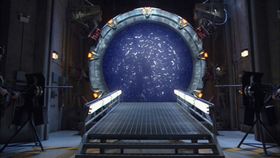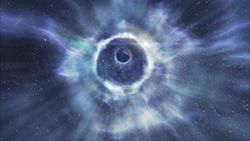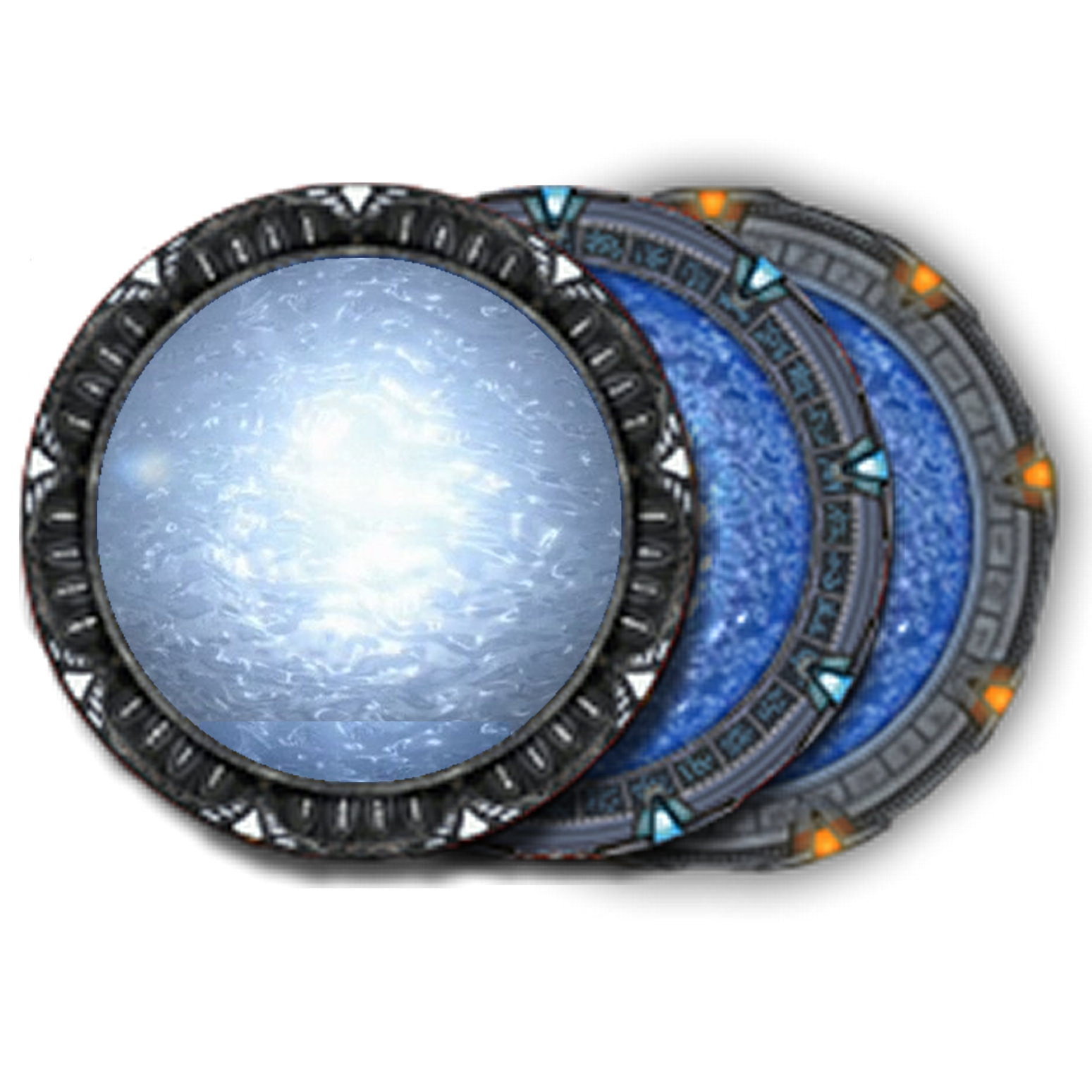Stargate franchise
| Stargate | |
 An active Stargate, the main device used in the franchise. | |
| Creator | Roland Emmerich, Dean Devlin |
|---|---|
| Original work | Stargate |
| Print publications | |
| Novels | Novels |
| Comics | Comics |
| Films and television | |
| Films | Stargate Stargate: The Ark of Truth Stargate: Continuum |
| Television series | Stargate SG-1 Stargate Atlantis Stargate Universe |
| Animated series | Stargate Infinity |
| Games | |
| Role-playing | Stargate SG-1 Roleplaying Game |
| Video games | Stargate: Resistance |
Stargate is an adventure military science fiction franchise, initially conceived by Roland Emmerich and Dean Devlin. The first film in the franchise was simply titled Stargate. It was originally released on October 28, 1994, by Metro-Goldwyn-Mayer, Carolco and Studio Canal, and became a hit, grossing nearly $200 million (USD) worldwide.[1][2] Three years later, Brad Wright and Jonathan Glassner created a television series titled Stargate SG-1 as a sequel for the film.
In addition to film and television, the Stargate franchise has expanded into other media, including books, video games, and comic books. These supplements to the film and television series have resulted in significant development of the show's fictional universe and mythology. In 2008, the films Stargate: The Ark of Truth and Continuum were released direct-to-DVD, which in total grossed over $21 million in the United States. In 2002 the franchise's first animated series, Stargate Infinity, began airing, which holds no canonicity in the franchise despite its Stargate SG-1-inspired plot. In 2004, the TV series Stargate Atlantis was released as a spin off from Stargate SG-1 and a third series, Stargate Universe, premiered on October 2, 2009. Stargate Universe was cancelled during its second season, leaving it on a cliffhanger. Then on April 17, 2011, Stargate producer Brad Wright announced that any plans for the continuation of the franchise had been cancelled indefinitely, ending 17 years of Stargate television production.[3]
Premise
Stargate productions center on the premise of a "Stargate", a ring-shaped device that creates a wormhole enabling personal transportation to complementary devices located cosmic distances away. Under the control of the United States government, the Stargate discovered on Earth is kept a secret from the public. This allows for storylines to present no contradiction between depicted events and reality, an effect compounded by setting Stargate in the present day and depicting Earth accurately, with any unrealistic technology originating solely from alien civilizations. These extraterrestrial civilizations are typically more pre-industrial than scientifically advanced and are almost always human. Together, this allows for stories predominated by human interaction in Earth-like environments, an unusual feature for a science fiction franchise focused on exploration of other worlds.
In the story, this is explained as being the result of alien interference in Earth's distant past—the concept influenced by the theories of Erich von Däniken.[4] Many ancient mythologies are shown to be the result of aliens who had visited Earth posing as gods by using their technology to give the impression of deific power. While some of these aliens had benign intentions, a race later known in Stargate SG-1 as the "Goa'uld" used Stargates to move slaves from Ancient Egypt to other habitable planets, simultaneously being responsible for the Egyptian religion and culture. Following a successful rebellion, the Goa'uld fled Earth, and the Stargate was buried and forgotten until modern times, when the United States acquired it following an archaeological dig. With the rediscovery of the function of the Stargate, the galaxy becomes a source of knowledge as well as threats, and the attention of the Goa'uld is drawn once more to Earth.
Stargate network
Several million years ago, an ancient race of advanced humanoid beings, now known as the Ancients, created a device capable of near-instantaneous transportation across the universe by means of a subspace wormhole. This device, which has been used by countless races since its creation, has more commonly become known as a "Stargate"— a name, discovered by Dr. Daniel Jackson, from hieroglyphics written by humans on Earth thousands of years ago. While various cultures have created their own name for the device, Stargate is among the most common used.

A Stargate itself is a device made out of a volatile mineral known as naquadah. It is between two Stargates that travel is possible. A stable wormhole in a Stargate is achieved by dialing the correct address in a mechanism named a DHD. In a DHD, an address of six symbols (representing constellations as seen from Earth for the Milky Way galaxy-style of gate) is imputed, plus a point of origin (a symbol unique to a particular Stargate that represents the location a person is dialing from), bringing the total up to seven symbols for an in-galaxy address. Eight symbols are required to establish a lock with a Stargate in another galaxy (such as the Pegasus galaxy). Nine symbols are required to dial Stargates that reside far across the universe - one notable destination is the gate aboard the Ancient spaceship Destiny, which was designed with the purpose of exploring the universe and Stargate networks established by the Seed ships that were launched prior. The Stargate contains nine chevrons spaced equally around its circumference. With each symbol that is locked, so is a chevron, making nine symbols the maximum number of symbols (or glyphs) that can be input. The design of the Stargates themselves tend to vary between galaxies. Three distinct designs are known; Stargates in the Milky Way galaxy, Pegasus galaxy, and that which resides on Destiny and are constructed by Seed ships. The varying designs of Stargates are largely the result of technological advancement; Destiny-style gates (the most primitive in design and function) were constructed first, followed by Milky-Way model gates, and lastly Pegasus-style gates.
Stargates play an extremely important role in each of the Stargate series. It is through these gates that races, mostly consisting of humanoid-like beings (particularly humans themselves), trade and explore. However, several races (such as the Goa'uld) often use the Stargate networks in far different, and deadlier, ways. Such races play an important role in the Stargate series, and are the driving force for the shows themselves.
- ↑ "Stargate (1994)". ''Box Office Mojo. Retrieved 2011-04-27.
- ↑ "Movie Stargate - Box Office Data, News, Cast Information - The Numbers". Nash Information Services, LLC.
- ↑ Colvin, Chad (April 17, 2011). "SGU continuation, other movies dead — for now". GateWorld. Retrieved April 17, 2011.
- ↑ "Roland Emmerich's Stargate film based on Erich von Daniken's research". Zoozle news. Retrieved March 19, 2011.

